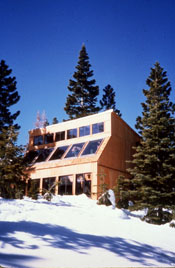how it works

natural energies
Natural energies are the free energies, which are available at any point on the earth's surface. These on-site energies include:
• GRAVITY
• EQUILIBRIUM ENERGY
• SOLAR ENERGY
• PHASE CHANGE ENERGY
When combined, these energies are effective in conditioning the atmosphere inside built environments, without reliance on mechanical systems or any kind of off-site energy. To understand and appreciate the potential for designing with natural energies, it is very important to understand the power of these energies individually.
gravity
Gravity is the attraction of two bodies for one another based on their mass. The energy of gravity is derived from the attraction of particles on the atomic and subatomic levels. Gravity as an energy source is responsible for the major wind and ocean currents. Gravity provides the energy required to stabilize the physical aspects of man and his environment. Gravity forces water downhill providing hydroelectric potential.
The phenomenon in which cold air, being heavier than warm air, is pulled to the earth by gravity, displacing warmer air, which then is pushed upward to a position formerly occupied by the colder air, is known as gravity convection. The use of gravity to control the interior conditions of our built environment dates back several thousand years. Whether understood or not, it has served to regulate and distribute the air inside every space which man has constructed.
Gravity is a very powerful force for moving air within our built environment, and has the capacity to act directly on the air, eliminating the need for any kind of mechanical system for the forced circulation of air. And in moving air, gravity acts to transfer heat.
equilibrium energy
The second form of on-site energy is the energy of equilibrium. Equilibrium is simply defined as a state of balance produced by the counteraction of two or more forces or influences in a system. For instance, when force or heat (energy) is either added to or subtracted from a system, the molecules in that system transfer the energy to balance or bring into equilibrium the effects of the energy transfer. As molecules become more tightly packed, their ability to distribute energy transfers evenly and quickly becomes greater. Another way of stating this is as mass increases; conductivity and heat absorption capacity increases.
The principles of equilibrium are fundamental to the laws of thermodynamics. When two systems are put in contact with each other, there will be a net exchange of enegy between them unless or until they are in thermal equilibrium. Furthermore, heat will transfer by direct contact or conduction or by radiation from a hotter object to a colder object in seeking a balance of the heat energy of the objects.
The energy of equilibrium transfers heat between existing buildings and the outside climate. In other words the energy of equilibrium is responsible in present building design for the lack of heat in the winter and the abundance of heat in the summer. The power of this energy should not be underestimated. Acting alone the energy of equilibrium is responsible for thermal discomfort in all existing buildings. However, this energy can be utilized to create and support, instead of detracting from, comfortable interior environmental conditions in buildings.
The same process of equilibrium is at work between the differences in temperatures of the air and the earth. By controlling the interaction of the temperatures of the earth and the air, the equilibrium process can be used to create a constant temperature level anywhere within the temperature range of the air and the earth. For instance, in Ekose’a Homes, the earth mass is used to warm cold air and cool warm air.
solar energy
The third form of energy is solar energy. Of all the energies, solar energy is perhaps the easiest to understand. It comes to earth directly from the sun in the form of electromagnetic waves. We see these waves as light and we feel these waves as heat.
Solar energy has received a great deal of attention recently, particularly as a source for producing electrical energy. While the sun may provide us with large amounts of useful energy, its availability varies greatly. In some parts of the world, solar energy is abundant and very strong while in others or during extreme winter conditions it is intermittent and relatively weak. Therefore, the design of Ekose’a Homes is not based primarily on solar energy as a source of heat energy. In fact, the concepts of Ekose’a Homes can be employed to design a comfortable built environment without the use of solar energy. Although Ekose’a Homes are based on the utilization and conservation of natural energies, solar energy is the only energy that can be taken out of the equation for the equation to remain valid.
In assimilating an understanding of the fundamental concepts of Ekose’a Homes, it is important to note that solar energy per se is not required to maintain building comfort. If the reader will accept this fact, then understanding how Ekose’a Homes work will become much easier.
phase change energy
The fourth form of on-site energy is phase change energy. This is the energy that is absorbed or released during a specified temperature and phase change. A phase change is the transition between solid, liquid, and gaseous states of matter. For example, the energy required to change one gram of water one degree centigrade is known as a calorie. When one gram of water at 100 degrees centigrade becomes one gram of steam at 100 degrees centigrade, 538 calories are absorbed. Water provides phase change energy of 538 calories/gram/degree C. Water can evaporate in a building system through vapor differences or temperature differences, or both. In evaporation, both a cooling and a dehumidifying-effect results.



